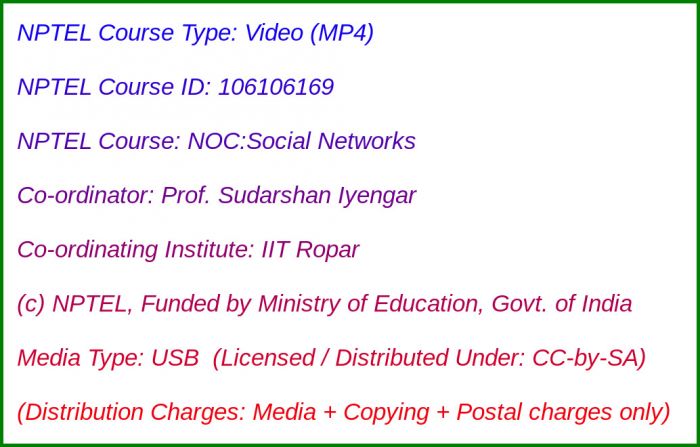
Media Storage Type : 64 GB USB Stick
NPTEL Subject Matter Expert : Prof. Sudarshan Iyengar
NPTEL Co-ordinating Institute : IIT Ropar
NPTEL Lecture Count : 166
NPTEL Course Size : 43 GB
NPTEL PDF Text Transcription : Available and Included
NPTEL Subtitle Transcription : Available and Included (SRT)
Lecture Titles:
Lecture 1 - Introduction
Lecture 2 - Answer to the puzzle
Lecture 3 - Introduction to Python - 1
Lecture 4 - Introduction to Python - 2
Lecture 5 - Introduction to Networkx - 1
Lecture 6 - Introduction to Networkx - 2
Lecture 7 - Social Networks: The Challenge
Lecture 8 - Google Page Rank
Lecture 9 - Searching in a Network
Lecture 10 - Link Prediction
Lecture 11 - The Contagions
Lecture 12 - Importance of Acquaintances
Lecture 13 - Marketing on Social Networks
Lecture 14 - Introduction to Datasets
Lecture 15 - Ingredients Network
Lecture 16 - Synonymy Network
Lecture 17 - Web Graph
Lecture 18 - Social Network Datasets
Lecture 19 - Datasets : Different Formats
Lecture 20 - Datasets : How to Download?
Lecture 21 - Datasets : Analysing Using Networkx
Lecture 22 - Datasets : Analysing Using Gephi
Lecture 23 - Introduction : Emergence of Connectedness
Lecture 24 - Advanced Material : Emergence of Connectedness
Lecture 25 - Programming Illustration : Emergence of Connectedness
Lecture 26 - Summary to Datasets
Lecture 27 - Introduction
Lecture 28 - Granovetter's Strength of weak ties
Lecture 29 - Triads, clustering coefficient and neighborhood overlap
Lecture 30 - Structure of weak ties, bridges, and local bridges
Lecture 31 - Validation of Granovetter's experiment using cell phone data
Lecture 32 - Embededness
Lecture 33 - Structural Holes
Lecture 34 - Social Capital
Lecture 35 - Finding Communities in a graph (Brute Force Method)
Lecture 36 - Community Detection Using Girvan Newman Algorithm
Lecture 37 - Visualising Communities using Gephi
Lecture 38 - Tie Strength, Social Media and Passive Engagement
Lecture 39 - Betweenness Measures and Graph Partitioning
Lecture 40 - Strong and Weak Relationship - Summary
Lecture 41 - Introduction to Homophily - Should you watch your company ?
Lecture 42 - Selection and Social Influence
Lecture 43 - Interplay between Selection and Social Influence
Lecture 44 - Homophily - Definition and measurement
Lecture 45 - Foci Closure and Membership Closure
Lecture 46 - Introduction to Fatman Evolutionary model
Lecture 47 - Fatman Evolutionary Model - The Base Code (Adding people)
Lecture 48 - Fatman Evolutionary Model - The Base Code (Adding Social Foci)
Lecture 49 - Fatman Evolutionary Model - Implementing Homophily
Lecture 50 - Quantifying the Effect of Triadic Closure
Lecture 51 - Fatman Evolutionary Model - Implementing Closures
Lecture 52 - Fatman Evolutionary Model - Implementing Social Influence
Lecture 53 - Fatman Evolutionary Model - Storing and analyzing longitudnal data
Lecture 54 - Spatial Segregation : An Introduction
Lecture 55 - Spatial Segregation : Simulation of the Schelling Model
Lecture 56 - Spatial Segregation : Conclusion
Lecture 57 - Schelling Model Implementation - 1 (Introduction)
Lecture 58 - Schelling Model Implementation - 2 (Base Code)
Lecture 59 - Schelling Model Implementation - 3 (Visualization and Getting a list of boundary and internal nodes)
Lecture 60 - Schelling Model Implementation - 4 (Getting a list of unsatisfied nodes)
Lecture 61 - Schelling Model Implementation - 5 (Shifting the unsatisfied nodes and visualizing the final graph)
Lecture 62 - Chapter - 5 Positive and Negative Relationships (Introduction)
Lecture 63 - Structural Balance
Lecture 64 - Enemy'S Enemy is a Friend
Lecture 65 - Characterizing the Structure of Balanced Networks
Lecture 66 - Balance Theorem
Lecture 67 - Proof of Balance Theorem
Lecture 68 - Introduction to positive and negative edges
Lecture 69 - Outline of implemantation
Lecture 70 - Creating graph, displaying it and counting unstable triangles
Lecture 71 - Moving a network from an unstable to stable state
Lecture 72 - Forming two coalitions
Lecture 73 - Forming two coalitions (Continued...)
Lecture 74 - Visualizing coalitions and the evolution
Lecture 75 - The Web Graph
Lecture 76 - Collecting the Web Graph
Lecture 77 - Equal Coin Distribution
Lecture 78 - Random Coin Dropping
Lecture 79 - Google Page Ranking Using Web Graph
Lecture 80 - Implementing PageRank Using Points Distribution Method - 1
Lecture 81 - Implementing PageRank Using Points Distribution Method - 2
Lecture 82 - Implementing PageRank Using Points Distribution Method - 3
Lecture 83 - Implementing PageRank Using Points Distribution Method - 4
Lecture 84 - Implementing PageRank Using Random Walk Method - 1
Lecture 85 - Implementing PageRank Using Random Walk Method - 2
Lecture 86 - DegreeRank versus PageRank
Lecture 87 - We Follow
Lecture 88 - Why do we Follow?
Lecture 89 - Diffusion in Networks
Lecture 90 - Modeling Diffusion
Lecture 91 - Modeling Diffusion (Continued...)
Lecture 92 - Impact of Commmunities on Diffusion
Lecture 93 - Cascade and Clusters
Lecture 94 - Knowledge, Thresholds and the Collective Action
Lecture 95 - An Introduction to the Programming Screencast (Coding 4 major ideas)
Lecture 96 - The Base Code
Lecture 97 - Coding the First Big Idea - Increasing the Payoff
Lecture 98 - Coding the Second Big Idea - Key People
Lecture 99 - Coding the Third Big Idea - Impact of Communities on Cascades
Lecture 100 - Coding the Fourth Big Idea - Cascades and Clusters
Lecture 101 - Introduction to Hubs and Authorities (A Story)
Lecture 102 - Principle of Repeated Improvement (A story)
Lecture 103 - Principle of Repeated Improvement (An example)
Lecture 104 - Hubs and Authorities
Lecture 105 - PageRank Revisited - An example
Lecture 106 - PageRank Revisited - Convergence in the Example
Lecture 107 - PageRank Revisited - Conservation and Convergence
Lecture 108 - PageRank, conservation and convergence - Another example
Lecture 109 - Matrix Multiplication (Pre-requisite 1)
Lecture 110 - Convergence in Repeated Matrix Multiplication (Pre-requisite 1)
Lecture 111 - Addition of Two Vectors (Pre-requisite 2)
Lecture 112 - Convergence in Repeated Matrix Multiplication- The Details
Lecture 113 - PageRank as a Matrix Operation
Lecture 114 - PageRank Explained
Lecture 115 - Introduction to Powerlaw
Lecture 116 - Why do Normal Distributions Appear?
Lecture 117 - Power Law emerges in WWW graphs
Lecture 118 - Detecting the Presence of Powerlaw
Lecture 119 - Rich Get Richer Phenomenon
Lecture 120 - Summary So Far
Lecture 121 - Implementing Rich-getting-richer Phenomenon (Barabasi-Albert Model) - 1
Lecture 122 - Implementing Rich-getting-richer Phenomenon (Barabasi-Albert Model) - 2
Lecture 123 - Implementing a Random Graph (Erdos-Renyi Model) - 1
Lecture 124 - Implementing a Random Graph (Erdos-Renyi Model) - 2
Lecture 125 - Forced Versus Random Removal of Nodes (Attack Survivability)
Lecture 126 - Rich Get Richer - A Possible Reason
Lecture 127 - Rich Get Richer - The Long Tail
Lecture 128 - Epidemics- An Introduction
Lecture 129 - Introduction to epidemics (Continued...)
Lecture 130 - Simple Branching Process for Modeling Epidemics
Lecture 131 - Simple Branching Process for Modeling Epidemics (Continued...)
Lecture 132 - Basic Reproductive Number
Lecture 133 - Modeling epidemics on complex networks
Lecture 134 - SIR and SIS spreading models
Lecture 135 - Comparison between SIR and SIS spreading models
Lecture 136 - Basic Reproductive Number Revisited for Complex Networks
Lecture 137 - Percolation model
Lecture 138 - Analysis of basic reproductive number in branching model (The problem statement)
Lecture 139 - Analyzing basic reproductive number - 2
Lecture 140 - Analyzing basic reproductive number - 3
Lecture 141 - Analyzing basic reproductive number - 4
Lecture 142 - Analyzing basic reproductive number - 5
Lecture 143 - Small World Effect - An Introduction
Lecture 144 - Milgram's Experiment
Lecture 145 - The Reason
Lecture 146 - The Generative Model
Lecture 147 - Decentralized Search - I
Lecture 148 - Decentralized Search - II
Lecture 149 - Decentralized Search - III
Lecture 150 - Programming illustration- Small world networks : Introduction
Lecture 151 - Base code
Lecture 152 - Making homophily based edges
Lecture 153 - Adding weak ties
Lecture 154 - Plotting change in diameter
Lecture 155 - Programming illustration- Myopic Search : Introduction>
Lecture 156 - Myopic Search
Lecture 157 - Myopic Search comparision to optimal search
Lecture 158 - Time Taken by Myopic Search
Lecture 159 - PseudoCores : Introduction
Lecture 160 - How to be Viral
Lecture 161 - Who are the right key nodes?
Lecture 162 - finding the right key nodes (the core)
Lecture 163 - Coding K-Shell Decomposition
Lecture 164 - Coding cascading Model
Lecture 165 - Coding the importance of core nodes in cascading
Lecture 166 - Pseudo core

